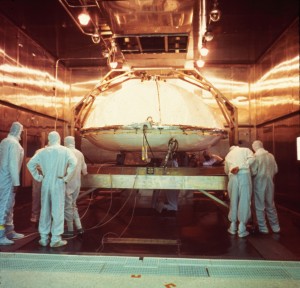19 December 2014
Sterilizing for Mars
Posted by kwheeling
By Nicholas Weiler
“Leave no trace.” It’s a central ethic of wilderness exploration. Pack your supplies in, pack your waste out, and leave the natural landscape unspoiled. But when it comes to the newest frontier of exploration—visiting alien worlds to search for evidence of extraterrestrial life—the challenge of avoiding contamination with traces of life from Earth is a huge challenge.

The new report lays out challenges for ensuring a future human mission to Mars doesn’t contaminate the Red Planet with human microbes.
Credit: NASA
“Every place we’ve explored there’s a parachute left on the ground or a heat shield or tracks left by a rover,” said David Beaty, who leads the Mars Exploration Directorate at NASA’s Jet Propulsion Laboratory in Pasadena, California. “Going somewhere and leaving no trace is not something we know how to do.”
As serious planning gets underway for eventual human exploration of Mars, an international forum of scientific experts, the Mars Exploration Program Analysis Group (MEPAG), has worked to create guidelines ensuring that the intrepid explorers of the future don’t contaminate potential hot spots for Martian life with microbes from back home.
MEPAG scientists, including JPL’s Beaty, presented highlights of their latest findings on how to safeguard these hot spots (called “special regions”) at a poster session Wednesday at the American Geophysical Union’s Fall Meeting. The full report was published in the journal Astrobiology in September.
“There was scientific concern right from the beginning of the space age about contaminating other worlds,” said coauthor Victoria Hipkin, the Canadian Space Agency’s senior scientist for planetary exploration. This concern is particularly acute for Mars, where researchers still hope to find traces of native organisms.
Since the 1976 Viking landers, NASA has heat-sterilized any craft heading for Mars. For cases where high-heat could damage delicate instruments, the agency has been developing alternative methods like pumping a ship full of hydrogen peroxide gas. But if human beings are ever to travel to the Red Planet, there’s no way to keep the mission completely sterile. Instead, researchers have focused on how to prevent inevitable microbial hitchhikers from getting a foothold on the Martian surface.

Since the Viking landers that reached Mars in 1976, NASA has scrupulously sterilized space-craft that could potentially bring Earthly microbes to alien worlds.
Credit: NASA
The new report brings together recent data about the Martian environment from Mars rovers and orbiters as well as new insights into the surprisingly extreme conditions under which earthly microbes can survive and thrive.
One of the fundamental tensions the new report highlights is that the same special regions where scientists believe they are most likely to find traces of life — where liquid water may be present for at least part of the Martian year — are also those where the danger is highest that opportunistic microbes from Earth could flourish and contaminate the research effort.
“How close can humans land to special regions without contaminating them?” Beaty asked. “We want to avoid messing up the experiment before we even make the measurements.”
The new research also highlights the need to find sites where a future human colony would have access to water, solar energy, and raw materials to produce fuel and other supplies without disrupting the special regions they had come to study, said astrobiologist John Rummel of East Carolina University, the lead author on the new report and a leader in planetary protection planning for NASA and the UN for over 25 years.
The best targets for future exploration may be geologic features such as seasonal gullies and caves in the mid-latitudes of Mars where there is likely to be plentiful water ice near the surface and also enough sun that the ice may turn into liquid water for at least part of the year, Rummel said.
Many issues remain to be worked out, Rummel said, including how to make sure any hypothetical Martian organisms don’t contaminate the human colony.
“If there is something alive on Mars, the challenge is also being sure you don’t bring it back to Earth with you,” he said, adding that this is particularly important if the alien life-form is unfamiliar and therefore hard to detect.
“It’s a dusty place,” Rummel said. “People assume you’ll be able to suit up, go outside, and come back in without bringing half of Mars with you.”
Nicholas Weiler is a science communication graduate student at UC Santa Cruz.


 GeoSpace is a blog on Earth and space science, managed by AGU’s Public Information staff. The blog features posts by AGU writers and guest contributors on all sorts of relevant science topics, but with a focus on new research and geo and space sciences-related stories that are currently in the news.
GeoSpace is a blog on Earth and space science, managed by AGU’s Public Information staff. The blog features posts by AGU writers and guest contributors on all sorts of relevant science topics, but with a focus on new research and geo and space sciences-related stories that are currently in the news.